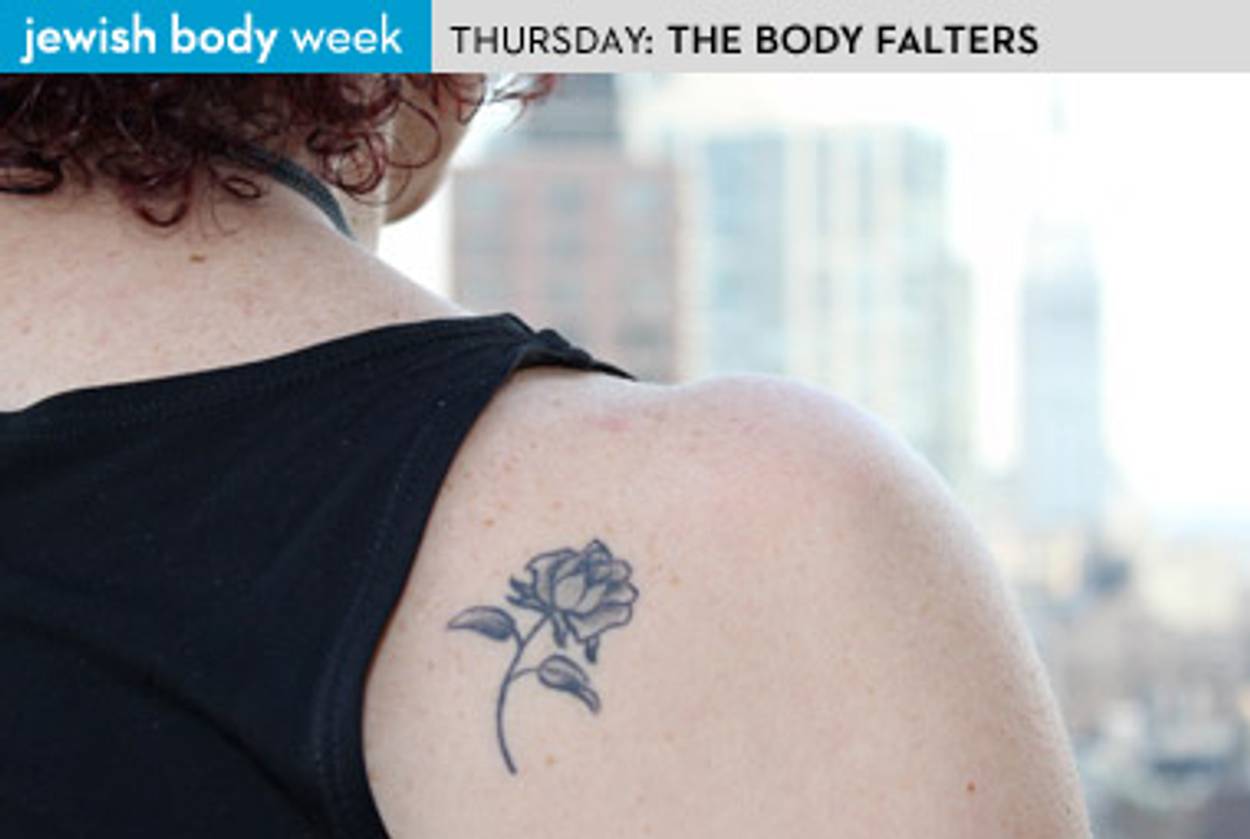My Rose Tattoo
To honor her body, the writer visits a Tel Aviv tattoo parlor




I remember a moment from my first trip to Israel 29 years ago. I was waiting for a friend at the entrance to Beit Hatfutsot, a museum on the Tel Aviv University campus. It was during a conference convened for Holocaust survivors, and as I watched older survivors flow out of the building, I glanced at the occasional uncovered arm to see the tattooed numbers there, remnants of their Holocaust experience. It was a powerful vision for a first-time visitor to Israel, one that underscored triumph over adversity and the human will to survive along with the need for the country as a safe haven for the Jews.
But now, as a regular visitor to Israel, I see a different country, especially in Tel Aviv, a city that has pioneered a free-flowing hedonistic lifestyle that promotes free expression in art and fashion. The campus of Tel Aviv University offers a parade of inked bodies. Which is partly why, though I’m not an Israeli, I decided to join Israel’s tattooed ranks during a visit this summer. But, unlike the bulk of Tel Aviv’s inked masses, I’d recently survived a harrowing ordeal, and a tattoo seemed as good a way as any to mark it.
The Jewish taboo against tattooing is culled from a verse in Leviticus: “You shall not make gashes in your flesh for the dead, or incise any marks on yourselves: I am the Lord.” There is a great deal of additional rabbinical commentary supporting this prohibition, including the notion that the human body is created in the image of God and, thus, to tamper with it is a kind of blasphemy. In recent times, the taboo has become more rooted in contemporary history than in biblical injunction—linked as it is to memory of the Holocaust. The sight of survivors’ tattoos traumatized a nation and a people, as it should have. A friend of mine whose grandparents perished in Auschwitz nearly threw his oldest son out of the house on their kibbutz when the son came home with a tattoo.
After making an appointment at Kipod on King George and Allenby Streets, I had to choose a design. Until I entered the tattoo studio, I had little sense of the final marking. But I knew where I wanted it to be (my upper right shoulder), and I knew that I wanted something that had a somewhat generic elegance to it, since it and I would grow old together.
I came equipped with pictures of lotuses and roses, different shapes and colors, but it wasn’t until I sat down in the studio and looked through the picture books that I decided on a final design: a rose with a sense of movement that makes it look like it is budding right on my back. And I chose the color black; Tel Aviv women may not dress in black from head to toe, but me and my fellow New Yorkers are persistently robed in it, and so it seemed to make sense to me to have my tattoo match the rest of my wardrobe.
The operative word in the previous sentence, though, is “chose.” As it turns out, my new rose is the third tattoo on my body—but the only one I asked for. Sixteen years ago, I was diagnosed with treatable breast cancer, and I had to go through a six-month radiation treatment. Prior to this treatment, the doctors outlined the area to be radiated with two tiny tattoos. Some women get these removed after their treatment, though it’s advisable to keep them in case you have a recurrence so that a doctor will see these telltale signs when considering further treatment.
Sometimes, I stare in the mirror and try to smudge away the unsmudgeable—these navy blue dots that appear intermixed with my natural body markings. These tattoos were not by choice; they mark an attack on my body and on my life by a deadly disease. As fixtures on my chest, they are reminders of the disease and of my triumph over it; but either way, they are reminders of a time in my life when I was out of control.
My new tattoo is something I did for me. It has no political or religious significance for me, nor does it show disrespect for my body, as the Leviticus passage implies. Rather it is a sign of respect for my body—and for me—to create a unique design on my skin that is not harmful. It doesn’t connote something dark or destructive. It’s about my own personal choice, making a decision for which I was fully in control. It’s playful and distinctive, like the city where I had it done, born from the past but not wedded to it, influenced by its own people’s history but not fated to relive it.
Jo-Ann Mort writes frequently about Israel and Palestine for a variety of publications.
Jo-Ann Mort writes frequently about Israel and Palestine for a variety of publications.